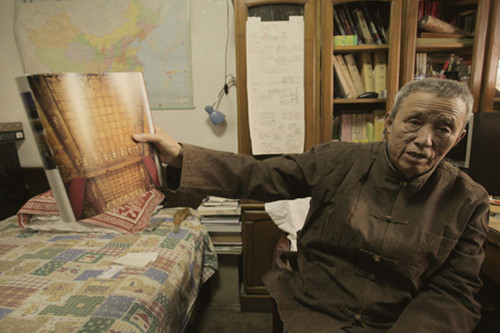
Wang Zhongjie, 79, has devoted more than 60 years to restoring color painting on ancient Chinese architecture. Yu ChenKang / China Daily
Wang joined the Palace Museum staff in the 1970s and began to study the designs and patterns on the imperial palaces.
Color painting was used in ancient China to decorate and protect the timber framework. It also represented the social status of royal families: Only the emperors were allowed to use dragon images and the empresses to use phoenix images. Ordinary people, including merchants and the wealthy, couldn't have such paintings on their buildings.
"Just look at Taihe Palace (a place to hold rituals of the royal family) in the Forbidden City, there are tens of thousands of dragons painted on beams, walls, ceilings and pillars," says Wang.
"As for Fengxian Palace, the place to hold ceremonies to worship ancestors, it's all painted with beaten gold," he says.
Though an expert, Wang still maintains his huge passion for fieldwork and surveys.
When Wanshou Temple in Beijing was under renovation in the 1990s, a craftsman called him for his help one night to determine the accurate pattern of color painting on a beam. Wang told him to prepare a torch and a ladder, and he immediately proceeded to the site.
It took him about 10 minutes to determine the pattern and guide the craftsman on the spot. But by the time he got back home, it was early morning - as the temple was located in a distant suburb.
Last year Wang went to an academic conference at Wudang Mountain in Hubei province. To observe the artwork on a mountaintop temple, the then already 79-year-old Wang climbed to the hillcrest, about 300 meters beyond where the upward-bound cable cars stopped.
"My students were nervous. They asked me not to do it. But I felt I was full of energy and excited to see the color painting of the temple," Wang laughs.
Every year, Wang goes to different cities across the country to help repair decorations on ancient buildings and temples. He loves it and is willing to share his knowledge, but he worries about how he will pass his skills to future generations.
"Young people now have better choices than a not-well-paid job like craftsman of ancient buildings," says Wang. "Scholars now prefer reading books to doing fieldwork.
"But traditional crafts and cultural protection need patience and devotion," he says.

Copyright ©1999-2011 Chinanews.com. All rights reserved.
Reproduction in whole or in part without permission is prohibited.